Previously on The Pixel Crush: "next week: sculpting!"
Sculpting!
I took Leonard's newly unwrapped torso and trousers and sculpted copious amounts of folds and detail into each, slightly forsaking the original concept design in the process. The amount of folds on his otherwise quite rigid clothing gives the impression of silk draped over cardboard but I don't really care because folds are awesome.
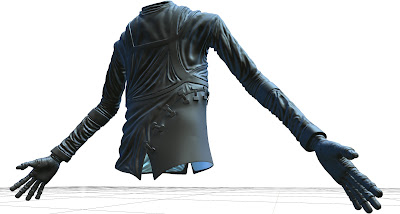 |
| Sculpt Front |
Though Dan did point out I went overboard on his glove to the point where they looked like medical gloves rather than gardening gloves so I went back in to the sculpt, added a seam, and flattened the palms for a more practical aesthetic.
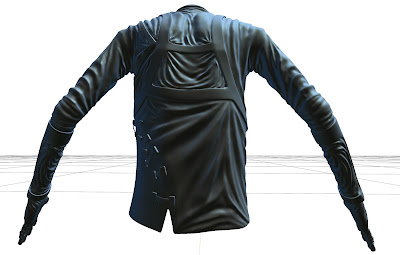 |
| Sculpt Back |
For the first time I have been experimenting with normal maps, a fancy form of bump mapping or a flat form of displacement mapping depending on your outlook on life. Or a way of adding detail to a model using a multi-coloured textures for those reading who aren't animation students/professionals. (Imagine if there were professionals other than our tutors reading these blogs...hey professionals!)
In order to generate a normal map, a technique used widely in videogames incidentally, you first need to have a high res sculpt of your base model, there are then various ways of storing the data of the surface. The 'normal' is the direction the surface of the model faces when it comes to calculating lighting, reflections etc. Tangent normals look like this for Leonard's torso and are perhaps the easiest to get to work properly as far as I've found.
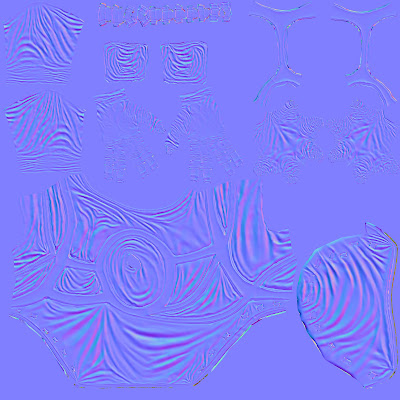 |
| Tangent Normals |
Object/world based normals look like this and are exceedingly pretty in a psychedelic way.
 |
| Object Based Normals |
In order to get them to work properly in Maya they had to be 32bit for some reason, something I need to look into because the texture would be much smaller in 8bit meaning (much) faster render times. This
polycount wiki is a great source of information on the subject.
Taking them into Maya I played around for a few hours trying to get them to look right before realising they needed to be 32bit in order to render properly without blowing out or breaking in certain areas. I was having problems with the object based normals where the UV seams met but using the 32bit format I switched to for the tangent normals probably would've fixed this.
Here's Leonard wearing his new garments.
Later I went back and sculpted the trousers too with their fancy interleaved ankle cuff things.
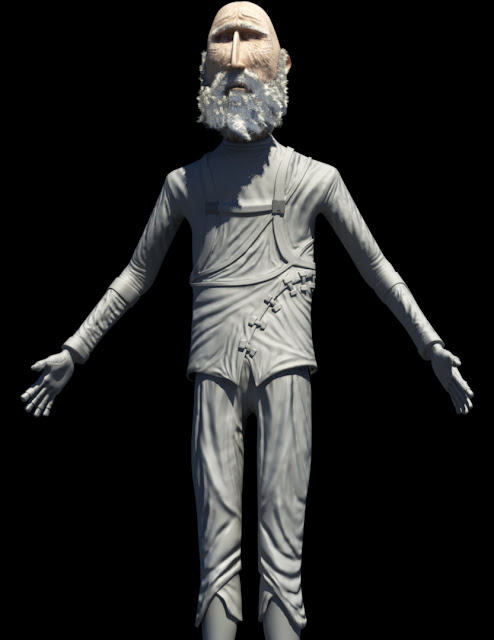 |
| Leonard in his new outfit |
I even tried a normal map on the face but the way the light scatters through his skin looks SO much more beautiful when its displaced properly that the plastic looking flatness of the normal map didn't work in the excellent way it does for his clothes. Here I've applied some really simple shaders just to test the specular properties of the clothing with the normal maps applied.
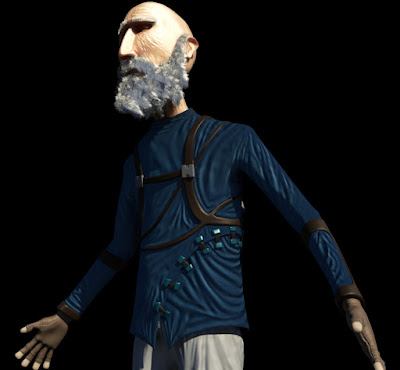 |
| Plastic Face |
Its all very smooth looking so next I began texturing using a lots of maps extracted from the Mudbox sculpt including ambient occlusion, displacement, and some photographs from my tiny collection of texture reference.
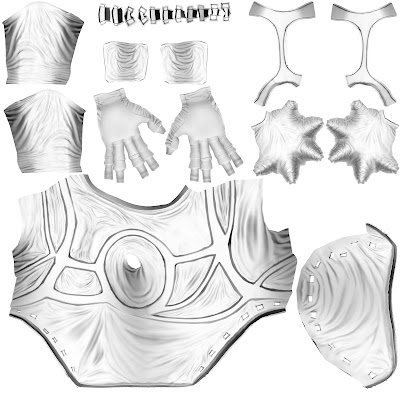 |
| Ambient Occlusion Map |
Using a really simple process of painting the base colour I wanted, then layering all the maps over the top and then adding a detail layer for cloth or dirt or leather I was able to create some textures I'm quite proud of. I often used the maps to mask out things like dirt so they were only in the cracks of things where Leonard couldn't clean them so easily. Blending modes between layers became really important as the standard way of applying ambient occlusion is using multiply but to get the skin and clothing looking natural you want to shadows to be shades of the base colour but darker, instead of the grey desaturating effect of ambient occlusion. So I ended up chopping this map into pieces with different blending modes.
Here's one I made earlier:
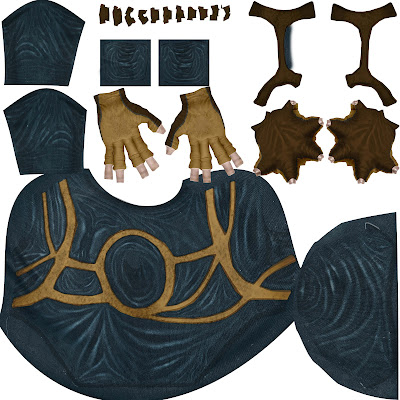 |
| Diffuse Texture |
Then came the endless tweaking of the shader attributes, something I usually enjoy but when you have all the shaders with 32bit normal maps attached to them the refresh rate of the little shader swatches slows right down meaning every time adjustment takes 15 seconds for the software to become responsive again. Tedious. If anyone knows a way of turning that refresh off let me know.
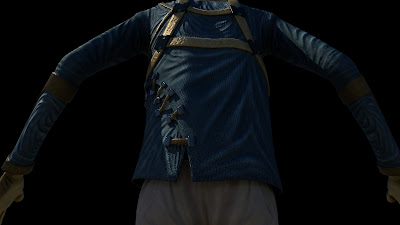 |
| Back |
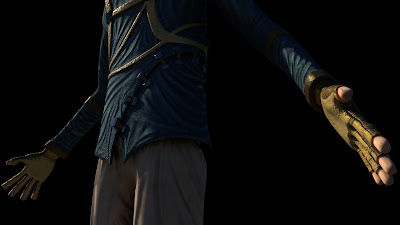 |
| Front |
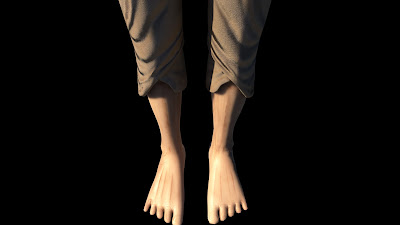 |
| Feet |
Its fantastic to be seeing Leonard's look so close to completion (I would say done but things always change) and now I'm aching to see him move and with
Luke hard at work on the rig with the majority of it done its looking promising. Leonard looks forward into a future of movement wistfully.
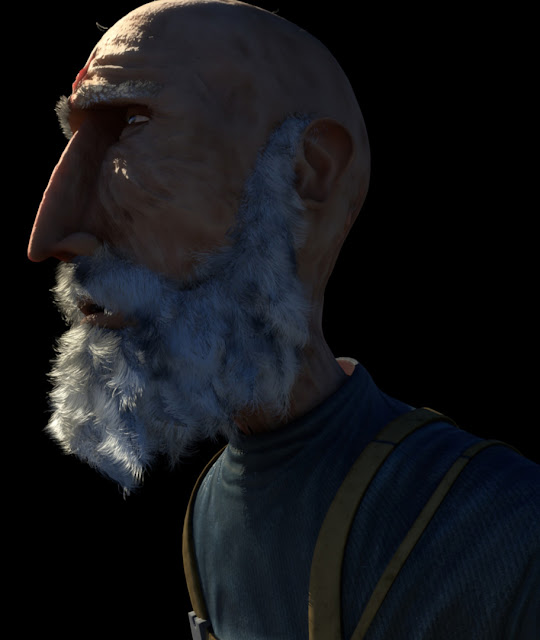 |
| Leonard Paisley, realised at last. |
A blog post concerning displacement maps wouldn't be the same without a glitch render so here you are:
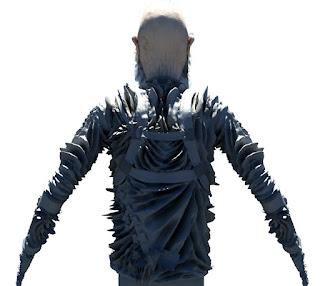 |
| WOOOOOH DISPLACEMENT YEAH! |
Meanwhile I finally completed that brain shot for the creativity documentary and with the help of some fancy depth of field I'm really pleased with the result.
I realised I kind of skimmed over that but this blog post is already too long and there's not much more to say about it that I haven't already apart some fancy compositing. I used chromatic abberation (very sparingly), bokeh depth of field, and film grain to just elevate to that higher level of photorealism I was aiming for (though I don't think I'll ever attain due to a chronic need to stylise things). I even, after ALL THIS TIME, found a way of adding motion blur in post without motion vectors in after effects. HOW HAVE THEY BEEN HIDING THIS?! Everybody go load after effects now, with an old animation, add the time warp effect, using the pixel motion at the top of the presets, set the speed to 100, click enable motion blur, manual, and adjust the shutter angle to your heart's content. F*CKING MAGIC. I'm in genuine shock.
Nearly done now, stay with me.
Kai, I believe, has completely blown me away (a pun I didn't even notice the first time) with this cloud he's created for Kernel that will contain Leonard's precious knowledge. I've been doing some very quick lighting tests just using point lights and trying different setups with and without shadows. Much still to do but already it looks brilliant.
If you reached the end of this post then you have some idea of what a monster of a week its been, and that's only a portion of it. Forgive me if I keep the propaganda quick, my brain is frazzled and I can't be bothered to check for typos.
Pixel Propaganda
The author of A Theory of Fun writes a blog post about
how narrative is not a game mechanic, and the structure of play once the narrative is removed is so exceedingly stupid that while it can make a great experience, its awful game design.
During all this sculpting Wayne Robson, autodesk Mudbox master (yes that's an actual title) released his
tutorial DVDs online for free. Well worth a look for basic and advanced Mudbox type informations.
Irrational Games, currently working on Bioshock Infinite, just announced a special way of playing the game when it comes out that will
enforce a degree of permanence to the player's narrative and game decisions. Intriguing.
Dear Esther comes out soon in its new shiny remake format. An interesting experiment in minimalist game design almost anyone can play and enjoy this on some level. Though I recommend doing it on a nice PC this game is gorgeous and not in a conventional sense.
A great article on the one man effort on a particular sequence in TrollHunter was published recently that is a great read for any CG generalist who has an interest in mastering every area of visual effects to an extent. Here's a breakdown of his character creation process:
Troll Hunter VFX - Ringlefinch from Rig to Render from
Rune Spaans on
Vimeo.

















No comments:
Post a Comment
Let The Discussion Begin: